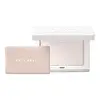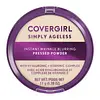Fenty Beauty Invisimatte Instant Setting + Blotting Powder Versus Covergirl Simply Ageless Instant Wrinkle Blurring Pressed Powder
What's inside
What's inside
 Key Ingredients
Key Ingredients

 Benefits
Benefits

 Concerns
Concerns

 Ingredients Side-by-side
Ingredients Side-by-side

Synthetic Fluorphlogopite
CI 77220
Cosmetic ColorantMagnesium Myristate
Hdi/Trimethylol Hexyllactone Crosspolymer
Octyldodecyl Stearoyl Stearate
EmollientPolymethylsilsesquioxane
Squalane
EmollientMica
Cosmetic ColorantCoconut Acid
Cleansing1,2-Hexanediol
Skin ConditioningCaprylyl Glycol
EmollientSilica
AbrasiveSalvia Hispanica Seed Extract
EmollientLeuconostoc/Radish Root Ferment Filtrate
AntimicrobialPhenoxyethanol
PreservativeSodium Hyaluronate
HumectantCI 77742
Cosmetic ColorantCI 77492
Cosmetic ColorantSynthetic Fluorphlogopite, CI 77220, Magnesium Myristate, Hdi/Trimethylol Hexyllactone Crosspolymer, Octyldodecyl Stearoyl Stearate, Polymethylsilsesquioxane, Squalane, Mica, Coconut Acid, 1,2-Hexanediol, Caprylyl Glycol, Silica, Salvia Hispanica Seed Extract, Leuconostoc/Radish Root Ferment Filtrate, Phenoxyethanol, Sodium Hyaluronate, CI 77742, CI 77492
Talc
AbrasiveMica
Cosmetic ColorantZinc Stearate
Cosmetic ColorantOctyldodecyl Stearoyl Stearate
EmollientIsopropyl Palmitate
Emollient1,2-Hexanediol
Skin ConditioningCaprylyl Glycol
EmollientPhenoxyethanol
PreservativeSorbitan Sesquioleate
EmulsifyingMethicone
EmollientAlumina
AbrasiveHydrogenated Lecithin
EmulsifyingSodium Hyaluronate
HumectantAscorbyl Glucoside
AntioxidantIron Oxides
CI 77891
Cosmetic Colorant
 Reviews
Reviews

Ingredients Explained
These ingredients are found in both products.
Ingredients higher up in an ingredient list are typically present in a larger amount.
1,2-Hexanediol is a synthetic liquid and another multi-functional powerhouse.
It is a:
- Humectant, drawing moisture into the skin
- Emollient, helping to soften skin
- Solvent, dispersing and stabilizing formulas
- Preservative booster, enhancing the antimicrobial activity of other preservatives
Caprylyl Glycol is a humectant and emollient, meaning it attracts and preserves moisture.
It is a common ingredient in many products, especially those designed to hydrate skin. The primary benefits are retaining moisture, skin softening, and promoting a healthy skin barrier.
Though Caprylyl Glycol is an alcohol derived from fatty acids, it is not the kind that can dry out skin.
This ingredient is also used as a preservative to extend the life of products. It has slight antimicrobial properties.
Learn more about Caprylyl GlycolMica is a naturally occurring mineral used to add shimmer and color in cosmetics. It can also help improve the texture of a product or give it an opaque, white/silver color.
Serecite is the name for very fine but ragged grains of mica.
This ingredient is often coated with metal oxides like titanium dioxide. Trace amounts of heavy metals may be found in mica, but these metals are not harmful in our personal products.
Mica has been used since prehistoric times throughout the world. Ancient Egyptian, Indian, Greek, Roman, Aztec, and Chinese civilizations have used mica.
Learn more about MicaOctyldodecyl Stearoyl Stearate is created from stearic acid.
It is an emollient and thickens the lipid (oil) portion of a product. Due to its emollient properties, it may not be fungal-acne safe.
Phenoxyethanol is a preservative that has germicide, antimicrobial, and aromatic properties. Studies show that phenoxyethanol can prevent microbial growth. By itself, it has a scent that is similar to that of a rose.
It's often used in formulations along with Caprylyl Glycol to preserve the shelf life of products.
Sodium Hyaluronate is hyaluronic acid's salt form. It is commonly derived from the sodium salt of hyaluronic acid.
Like hyaluronic acid, it is great at holding water and acts as a humectant. This makes it a great skin hydrating ingredient.
Sodium Hyaluronate is naturally occurring in our bodies and is mostly found in eye fluid and joints.
These are some other common types of Hyaluronic Acid:
Learn more about Sodium Hyaluronate